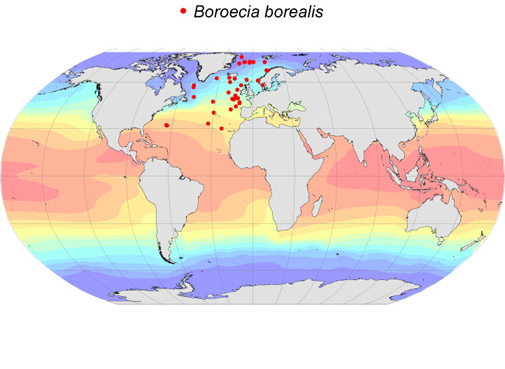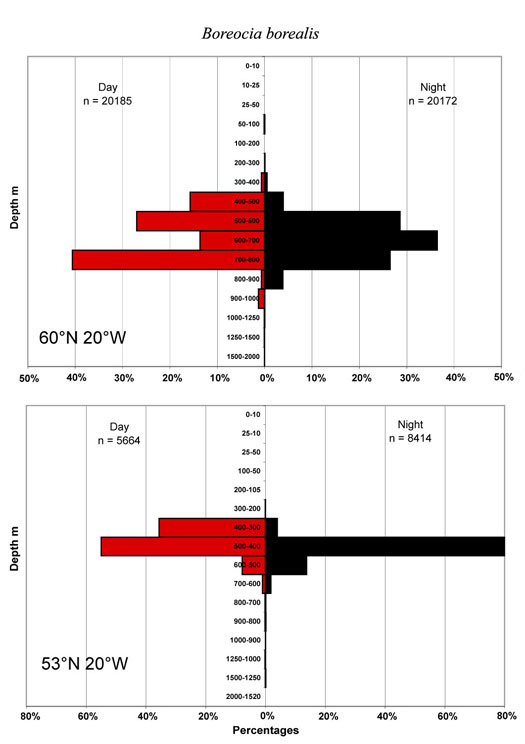Atlas of Atlantic Ostracods
Taxon details
Boroecia borealis (Sars, G.O., 1866)
- Order:
- MYODOCOPA
- Suborder:
- Halocypridina
- Family:
- Halocyprididae
- Subfamily:
- Conchoecinae
- Size range (females):
- 2.4-2.9 mm
- Size range (males):
- 2.1-2.3 mm
- Depth:
- mesopelagic
Notes
280 records
First described from off the Lofoten Islands in the Norwegian Sea, this species is abundant and often dominant at mesopelagic depths in the North Atlantic at boreal latitudes. It is endemic to the North Atlantic. In the northern sector of its range it is largely displaced by its larger sibling species B. maxima, but Müller (1906, 1912) supported later by Skogsberg (1920) considered the two species were synonymous with B. maxima being the junior synonym. We have been re-examining the genus and have confirmed Poulsen’s (1973) conclusion that these two species are distinct. Both species occur off Svalblad, with maxima being dominant. Hence we are confident that the Russian records of this species high in the Arctic are reliable. It is probably advected to high latitudes in the inflow of Atlantic water, so its occurrence at latitudes >80°N is probably indicative of this inflow.
At the southern end of its range it submerges and at 30°N it is a rare component of the deep bathypelagic community. For many years, it was considered to be a bipolar species with a Southern Ocean subspecies B. borealis antipoda (Müller 1906). However, Poulsen (1973) considered that all three species, despite their similarities, to be separate entities. Angel and Blachowiak-Samolyk (in press), are re-confirming their separate identities and will be describing two new taxa from the Pacific. All records that predate Poulsen’s (1973) final separation of the species need to be assessed critically, and even later papers have perpetuated the confusion. For example Haberstroh (1985) and Richter (1994) were advised to consider B. borealis and B. maxima as synonyms. However, they give detailed size data which confirm that the majority of their specimens from the East Greenland Current were B. maxima. Apart from their disparity in size, the two species are readily differentiated by the shoulder vaults being sharp edged in B. borealis, and rounded in maxima, even in juvenile instars. borealis is often a dominant component of very simple species-poor halocyprid communities (e.g. in the Labrador Sea and off northern Norway) and so the very early stage juveniles, which show very few characters whereby they can be identified, can be attributed with reasonable certainty.
| Labrador Sea | n | Mean mm | s.d. | Range mm |
|---|---|---|---|---|
| Female | 49 | 2.59 | 0.066 | 2.44-2.72 |
| Male | 30 | 2.19 | 0.051 | 2.04-2.26 |
| A-1 | 82 | 1.73 | 0.047 | 1.69-1.82 |
| A-2 | 146 | 1.18 | 0.039 | 1.10-1.24 |
| A-3 | 163 | 0.81 | 0.026 | 0.72-0.86 |
| A-4 | 116 | 0.59 | 0.025 | 0.52-0.66 |
| A-5 | 117 | 0.42 | 0.020 | 0.38-0.48 |
| 60°N 20°W | n | Mean mm | s.d. | Range mm |
|---|---|---|---|---|
| Female | 59 | 2.52 | 0.062 | 2.40-2.64 |
| Male | 82 | 2.11 | 0.043 | 2.02-2.22 |
| A-1 | 155 | 1.71 | 0.038 | 1.64-1.80 |
| A-2 | 164 | 1.15 | 0.031 | 1.08-1.26 |
| A-3 | 125 | 0.79 | 0.027 | 0.74-0.88 |
| A-4 |
| 44°N 13°W | n | Mean mm | s.d. | Range mm |
|---|---|---|---|---|
| Female | 7 | 2.43 | 2.30-2.52 | |
| Male | 5 | 2.06 | 2.02-2.14 | |
| A-1 | 43 | 1.67 | 0.050 | 1.54-1.80 |
| A-2 | 120 | 1.12 | 0.048 | 0.96-1.28 |
| A-3 | 41 | 0.77 | 0.041 | 0.70-0.90 |
| A-4 |





